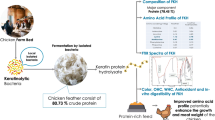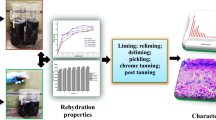Abstract
Present study aims to enhance protease production by employing locally isolated bacterial strains using animal skin (beef) wastes as a substrate. A proximate analysis of the substrate (skin waste) was carried out to know the percentage of protein, fats, and ash. To understand the particle size, shape, and other structural changes, scanning electron microscope (SEM) and Fourier transform infrared spectroscopy (FTIR) of both untreated and treated samples were performed. The substrate showed 83.81% crude protein, 11.23% crude fat, and 4.96% ash contents. SEM and FTIR analysis revealed changes in treated samples as compared to that untreated skin waste (control). In 140 isolated strains, 60 strains showed clear zone on 1% skim milk agar medium. The selected strains were cultured for protease assay on a production medium. The maximum protease (249.65 IU/ml) producing strain was identified as Bacillus cereus AUST-7 morphologically, biochemically, and based on 16S rDNA gene sequencing. The bioprocess parameters like aeration rate, shaking speed, and incubation period were optimized in lab scale bioreactor of 1.5 L capacity. During scale-up in a bioreactor (1.5 L), 2 volumes of aeration rate per volume of liquid medium per minute (VVM) aeration, shaking speed of 500 rpm, and 24 h of incubation period yielded maximum protease (1917.5 IU/mL) under submerged fermentation. The results depicted that defatted skin waste could be utilized as a potential substrate for the cost-effective production of alkaline protease.






Similar content being viewed by others
Data availability
All the data generated in this research work has been included in this manuscript.
References
Agarwal PK (2006) Enzymes an integrated view of structure, dynamics and function. Microb Cell Fact 12:1–12
Gupta R, Beg KQ, Lorenz P (2002) Bacterial alkaline proteases : molecular approaches and industrial applications. Appl Microbiol Biotechnol 59:15–32
Hosseini SV, Saffari Z, Farhanghi A, Atyabi SM, Norouzian D (2016) Kinetics of alkaline protease production by Streptomyces griseoflavus PTCC1130. Iran J Microbiol 8(1):8–13
Karigar CS, Rao SS (2011) Role of microbial enzymes in the bioremediation of pollutants: a review. Enzyme Res 1(1):11
Raveendran S, Parameswaran B, Ummalyma SB, Abraham A, Mathew AK, Madhavan A (2018) Applications of microbial enzymes in food industry. Food Technol Biotechnol 56(1):16–30
Kalisz HM (1988) Microbial proteinases. Adv Biochem Eng Biotechnol 36:1–65
Anwar A, Saleemuddin M (1998) Alkaline proteases, a review. Bioresour Technol 64:175–183
Rathod MG, Pathak AP (2016) Optimized production, characterization an application of alkaline proteases from taxonomically assessed microbial isolates from Lonar soda lake. India Biocatal Agric Biotechnol 7:164–173
Hakim A, Bhuiyan FR, Qbal A, Emon TH, Ahmed J, Azad AK (2018) Production and partial haracterization of dehairing alkaline protease from Bacillus subtilis AKAL7 and Exiguobacterium indicum AKAL11 by using organic municipal solid wastes. Heliyon 4:e00646
Arya P, Jani SA, Rajput KN, Raval V (2020) Thermostable alkaline proteases from bacteria: a review (March 4, 2020). Proceedings of the National Conference on Innovations in Biological Sciences (NCIBS) 2020, Available at SSRN: https://ssrn.com/abstract=3562387. Accessed March 2020
Jadhav HP, Sonawane MS, Khairnar MH, Sayyed RZ (2020) Production of alkaline protease by rhizospheric Bacillus cereus HP_RZ17 and Paenibacillus xylanilyticus HP_RZ19. J Environ Sustain: 1–9.
Maughan H, Van der Auwera G (2011) Bacillus taxonomy in the genomic era finds phenotypes to be essential though often misleading. Infect Genet Evol 11(5):789–797
Mohammed Y, Lee B, Kang Z, Du G (2014) Development of a two-step cultivation strategy for the production of vitamin B12 by Bacillus megaterium. Micr Cell Fact 13:102
Takano H (2016) The regulatory mechanism underlying light-inducible production of carotenoids in non-phototrophic bacteria. Biosci Biotechnol Biochem 80:1264–1273
Ellaiah P, Srinivasulu B, Adinarayana K (2002) A review on microbial alkaline proteases. J Sci Ind Res 61:690–704
Malik H, Hadi S, Shahzad MI, Irfan M, Ali S, Muhammad A (2017) Isolation and identification of protease enzyme producing Bacillus subtilis from soil. PSM Microbiol 2(1):15–19
Alocilja EC, Radke SM (2003) Market analysis of biosensors for food safety. Biosens Bioelectron 18:841–846
Pal S, Alocilja EC, Downes FP (2007) Nanowire labeled direct-charge transfer biosensor for detecting Bacillus species. Biosens Bioelectron 22:2329–2336
Seng P, Drancourt M, Gouriet F, La Scola B, Fournier PE, Rolain JM, Raoult D (2009) Ongoing revolution in bacteriology: routine identification of bacteria by matrix-assisted laser desorption ionization time-of-flight mass spectrometry. Clin Infect Dis 49(4):543–551
Contreras AR, Koller M, Dias MMD, Calafell-Monfort M, Braunegg G, Marques-Calvo MS (2013) High production of poly [3-hydroxybutyrate] from a wild Bacillus megaterium Bolivian strain. J Appl Microbiol 114(5):1378–1387
Sumita D, Mukul D, Sakshi M, Subhash KK (2015) Toxic hazards of leather industry and technologies to combat threat. JCLEPRO 87:39–49
Sundar JV, Gananami A, Muralidharan C, Mandal AB (2011) Recovery and utilization of proteinous wastes of leather making 10:151–163
Kanagaraj J, Velappan KC, Chanra BNK, Sadulla S (2006) Solid waste generation in leather industry and its utilization for cleaner environment- A Review. J Sci Ind Res 65:541–548
Ward OP (1985) Pro-teolytic enzymes. In: Moo-Young M (ed) Comprehensive biotechnology, the practice of biotechnology current commodity products, 3. Pergamon Press, Oxford, pp 789–818
Ullah N, Rehman MU, Sarwar A, Nadeem M, Nelofer R, Shakir HA, Irfan M, Idrees M, Naz S, Nabi G et al (2022) Purification, characterization, and application of alkaline protease enzyme from a locally isolated Bacillus cereus strain. Fermentation 8:628
Ramamoorthy G, Sehgal PK, Mahendra K (1989) Improved uptake of basic chromium salts in tanning operations using keratin hydrolysate. J Soc Leather Technol Chem 73:168–170
Yang SS, Huang CI (1994) Proteases production by amylolytic fungi in solid state fermentation. J Chinese Agri Chem Soc 32:589–601
Holt JG, Krieg NR, Sneath PHA, Stately JT, William ST (1994) Bergey’s manual of determinative bacteriology, 9th edn. Williams and Wilkins, Baltimore, Maryland, USA, p 559
Betty AF, Daniel FS, Alice SW (2002) Overview of bacterial identification methods and strategies. In: Bailey and Scott’s Diagnostic Microbiology. 11th Ed., Published by Mosby Inc. USA, pp. 225–283. https://doi.org/10.1093/clinchem/48.10.1816
Khalid S, Irfan M, Shakir HA, Qazi JI (2017) Endoglucanase producing potential of Bacillus species isolated from the gut of Labeo rohita. J Mar Sci Technol 25(5):581–587
Thompson JD, Higgins DG, Gibson TJ (1994) CLUSTAL W: improving the sensitivity of progressive multiple sequence alignment through sequence weighting, position-specific gap penalties and weight matrix choice. Nucleic Acids Res 22(22):4673–4680
Tamura K, Peterson D, Peterson N, Stecher G, Nei M, Kumar S (2011) MEGA5: molecular evolutionary genetics analysis using maximum likelihood, evolutionary distance, and maximum parsimony methods. Mol Biol Evol 28(10):2731–2739
Kumar AG, Swarnalatha S, Sairam B, Sekaran G (2008) Production of alkaline protease by Pseudomonas aeruginosa using proteinaceous solid waste generated from leather manufacturing industries. Bioresource technol 99(6):1939–1944
Ahmad J, Ansari TA (2013) Alkaline protease production using proteinaceous tannery solid waste. J Pet Environ Biotechnol 4:1
Kumar AG, Venkatesan R, Prasad Rao B, Swarnalatha S, Sekaran G (2009) Utilization of tannery solid waste for protease production by Synergistes sp. in solid-state fermentation and partial protease characterization. Eng. Life Sci 9(1):66–73
Akwetey WY, Eremong DC, Donkoh A (2013) Chemical and nutrient composition of cattle hide (“Welle”) using different processing methods. J Animal Sci Adv 3:176–180. https://doi.org/10.5455/jasa.20130430123444
Ozgunay H, Colak S, Mutlu MM, Akyuz F (2007) Characterization of leather industry wastes. Polish J Environ Stud 16:867–873
Erwanto Y, Muttaqien AT, Sugiyono, Sismindari, Rohman A (2016) Use of Fourier transform infrared (FTIR) spectroscopy and chemometrics for analysis of lard adulteration in “Rambak” crackers. Int J Food Prop 19:10
Govarthanan M, Park SH, Kim JW, Lee KJ, Cho M, Kamala-Kannan S, Oh BT (2014) Statistical optimization of alkaline protease production from brackish environment Bacillus sp. SKK11 by SSF using horse gram husk Prep. Biochem Biotechnol 44(2):119–131
Sarkar G, Suthindhiran K (2020) Extraction and characterization of alkaline protease from Streptomyces sp. GS-1 and its application as dehairing agent. Biocatal Agric Biotechnol 101590. https://doi.org/10.1016/j.bcab.2020.101590
Josephine FS, Ramya VS, Devi N, Ganapa SB, Siddalingeshwara KG, Venugopal N, Vishwanatha T (2012) Isolation, production and characterization of protease from Bacillus sp. isolated from soil sample. J Microbiol Biotech Res 2(1):163–168
Ammar MS, El-Louboudy SS, Abdulraouf UM (1991) Protease (s) from Bacillus anthracis S-44 and B. cereus var. mycoids, S-98 isolated from a temple and slaughter house in Aswan city. J. Microbiol 13:12–29
Ookkheo B, Sinchaikul S, Phutrakul S, Chen ST (2000) Purification and characterization of the highly thermostable proteases from Bacillus stearothermophilus TLS33. Protein Expr Purif 20(2):142–151
Kanekar PP, Nilegaonkar SS, Sarnaik SS, Kelkar AS (2002) Optimization of proteases activity of alkaliphilic bacteria isolated from an alkaline lake in India. Bioresource Technol 85(1):87–93
Ayantunji YJ, Omole RK, Olojo FO, Awojobi KO (2020) Optimization of alkaline protease production in submerged fermentation using Bacillus cereus isolated from an abattoir wastewater in Ile-Ife, Nigeria. J Adv Biol 23(3):1–15. https://doi.org/10.9734/jabb/2020/v23i330143
Rathnasamy SK, Durai A, Vigneshkumar AA, Purushothaman C, Rajendran DS, Chandramouliswaran K (2020) One-pot simultaneous production and sustainable purification of fibrinolytic protease from Bacillus cereus using natural deep eutectic solvents. Sci Rep 10(1):1–16
Suberu Y, Akande I, Samuel T, Lawal A, Olaniran A (2019) Optimization of protease production in indigenous Bacillus species isolated from soil samples in Lagos, Nigeria using response surface methodology. Biocatal Agric Biotechnol 18:101011
Asha B, Palaniswamy M (2018) Optimization of alkaline protease production by Bacillus cereus FT 1 isolated from soil. J Appl Pharm Sci 8(02):119–127
Kebabci Ö, Cihangir N (2011) Full Length Research Paper Isolation of protease producing novel Bacillus cereus and detection of optimal conditions. Afr J Biotechnol 10(7):1160–1164
Bhardwaj P, Anjum S, Dahiya P (2020) Purification and characterization of novel solvent stable Bacillus cereus pi-c4 protease from poultry waste. J Microbiol Biotechnol Food Sci 9(5):865–869
Zambare V, Nilegaonkar S, Kanekar P (2011) A novel extracellular protease from Pseudomonas aeruginosa MCMB-327: Enzyme production and its partial characterization. New Biotechnol 28(2):173–181
Waghmare SR, Gurav AA, Mali SA, Nadaf NF (2015) Purification and characterization of novel organic solvent tolerant 98 kDa alkaline protease from isolated Stenotrophomonas maltophilia strain SK. Protein Exp Purifi 107:1–6
Nadeem M, Qazi JI, Baig S (2009) Effect of aeration and agitation rates on alkaline protease production by Bacillus licheniformis UV-9 mutant. Türk Biyokimya Dergisi 34(2):89–96
Author information
Authors and Affiliations
Contributions
Conceptualization, M.R and N.U.; methodology, N.U and M.N.; software, R.N.; validation, NU, A.S., S.N, M.Y.S, and U.A.; formal analysis, M.I.; investigation, M.I.D.; resources, T.A.; data curation, T.A.; writing—original draft preparation, N.U, S.N, and A.H.; writing—review and editing, T.A.; visualization, A.S and T.A.; supervision, M.I.R.; project administration, T.A.; funding acquisition, N.U. The manuscript was written through the contributions of all authors. All authors have approved the final version of the manuscript. All the authors contributed equally.
Corresponding author
Ethics declarations
Ethical approval
Not applicable.
Competing interests
The authors declare no competing interests.
Additional information
Publisher's note
Springer Nature remains neutral with regard to jurisdictional claims in published maps and institutional affiliations.
Rights and permissions
Springer Nature or its licensor (e.g. a society or other partner) holds exclusive rights to this article under a publishing agreement with the author(s) or other rightsholder(s); author self-archiving of the accepted manuscript version of this article is solely governed by the terms of such publishing agreement and applicable law.
About this article
Cite this article
Ullah, N., Mujaddad-ur-Rehman, M., Sarwar, A. et al. Effect of bioprocess parameters on alkaline protease production by locally isolated Bacillus cereus AUST-7 using tannery waste in submerged fermentation. Biomass Conv. Bioref. (2023). https://doi.org/10.1007/s13399-023-04498-x
Received:
Revised:
Accepted:
Published:
DOI: https://doi.org/10.1007/s13399-023-04498-x




